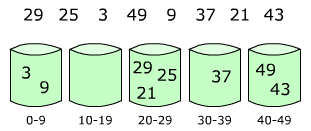Example of insertion sort sorting a list of random numbers. | |
| Class | Sorting algorithm |
|---|---|
| Data structure | Array |
| Worst-case performance | |
| Best-case performance | |
| Average performance | |
| Worst-case space complexity | |


ProxmapSort, or Proxmap sort, is a sorting algorithm that works by partitioning an array of data items, or keys, into a number of "subarrays" (termed buckets, in similar sorts). The name is short for computing a "proximity map," which indicates for each key K the beginning of a subarray where K will reside in the final sorted order. Keys are placed into each subarray using insertion sort. If keys are "well distributed" among the subarrays, sorting occurs in linear time. The computational complexity estimates involve the number of subarrays and the proximity mapping function, the "map key," used. It is a form of bucket and radix sort.
Once a ProxmapSort is complete, ProxmapSearch can be used to find keys in the sorted array in time if the keys were well distributed during the sort.
Both algorithms were invented in the late 1980s by Prof. Thomas A. Standish at the University of California, Irvine.


